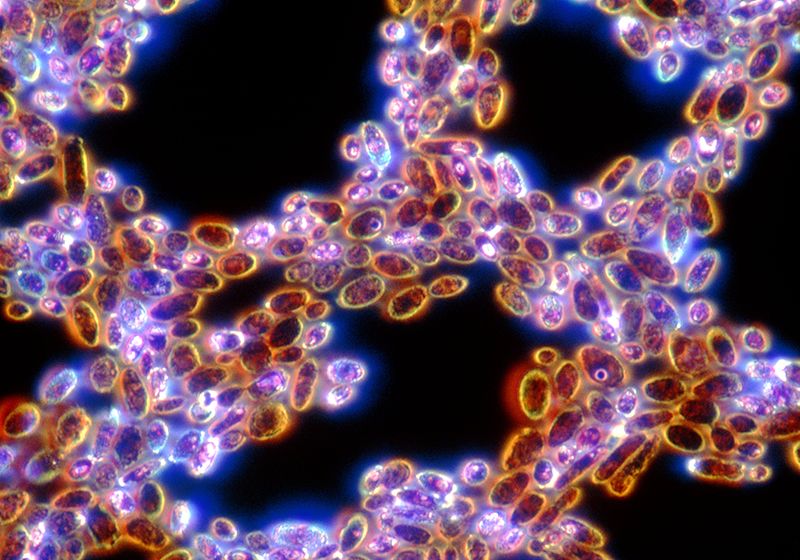Patches of seemingly meaningless DNA dotted throughout the genome might actually have a function: helping cells to survive starvation.
Two studies published in Nature on 16 January suggest that these stretches of non-coding DNA called introns help to control the rate at which cells grow, conserving energy when food becomes scarce.
Genes carry the information needed to make proteins. But many genes contain introns: sequences of non-coding DNA, the vast majority of which don’t appear to do anything.
Some researchers suspected introns did more than meets the eye.
In one of the latest studies1, Sherif Abou Elela, a microbiologist at the University of Sherbrooke in Quebec, Canada, and his colleagues examined baker’s yeast (Saccharomyces cerevisiae), whose DNA has 295 introns. They spent ten years meticulously creating hundreds of yeast strains, each missing just one of its introns.
“Everybody laughed and said we were crazy,” says Abou Elela.
Starvation response
At first, the team found that modified yeast strains grew just like the unmodified, ‘wild-type’ strain under laboratory conditions.
But when the researchers grew the altered yeast in nutrient-poor conditions alongside wild-type yeast, 64% of the modified strains died out, whereas the wild types survived.
The researchers surmised that many of the introns helped the wild yeast to cope with a lack of food. Further experiments illuminated the mechanism behind the introns’ role in a cell.
The way of an intron
When a cell makes a protein from a gene, the gene sequence is first copied from the DNA onto a messenger RNA, which is the template for the protein. Before the protein is assembled, the introns are cut out of the RNA by a molecular machine called a spliceosome.
Abou Elela’s team found that in many of the yeasts lacking one of their introns, the remaining introns weren’t cut out of the messenger RNAs.
And when nutrients were scarce, the genes for proteins that make up the ribosomes ― cellular machines that assemble proteins ― were more active than those in wild-type yeast.
Ribosomes require a lot of energy, and during periods of starvation, cells normally repress ribosomal-protein-related genes to conserve energy. The modified yeast strains, however, did not generally do this.
The team concluded that in normal cells with introns, those introns repress ribosomal-protein genes when food is in short supply to conserve energy.
Abou Elela says that “70 to 80% of the introns have the same effect. We have found an entirely new way for the cell to regulate itself when nutrients are depleted.”
Controlling growth
In the second study2, Jeffrey Morgan, a biomedical engineer at the Massachusetts Institute of Technology in Cambridge, and his colleagues examined how efficiently yeast make proteins when under nutritional stress.
They found that in normal cells with introns in their DNA, the introns were cut out of the messenger RNA and destroyed unless a cell was starved. When a cell was starved, those cut-out RNA introns were accumulating in the cell.
And the team has linked this accumulation to a protein called TORC1, which regulates cell growth and the production of ribosomes. When they inhibited TORC1, introns were not destroyed anymore, Morgan says.
This led the team to a similar conclusion as Abou Elela. “We think the ultimate way these introns are affecting cell growth is to help [suppress] ribosome production,” says Morgan.
Although the details are different, both studies found that introns can repress the production of ribosomal proteins, helping the yeast cells to save energy when food is short.
“I do find the core observation of both pieces convincing,” says Manuel Ares, Jr, a molecular biologist at the University of California, Santa Cruz. “It seems unlikely two groups would come to something this unexpected if it wasn’t true.”
The scientists are now eager to see whether introns play similar roles in other species.
“It’d be surprising if biology just did this in one species and not in others,” says Morgan’s supervisor, biologist David Bartel.
Jay Hesselberth, a molecular geneticist at the University of Colorado in Aurora says that this work could also have implications for the roles of introns in mammals, including humans, and that we might have missed some of the functions of non-coding DNA.
Bartel agrees, but adds that the findings do not necessarily mean that most non-coding DNA has a function.







